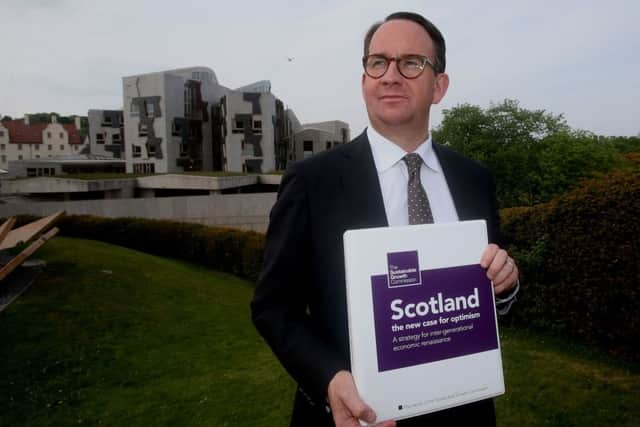Independent Scotland economy would need 25 years to catch up
After a Yes vote, Scotland would also make a £5 billion a year “solidarity payment” to the rest of the UK and endure a decade of tough public spending choices to tackle its £13.3bn deficit.
Scotland would keep the pound after independence and would have around a decade to get its economy into a fit state to establish its own separate currency.
Advertisement
Hide AdAdvertisement
Hide AdThe long-awaited SNP Sustainable Growth Commission document, ordered by Nicola Sturgeon, said that a new Scottish currency could only be established once six rigorous financial tests had been met.


Last night the author of the 354-page document Andrew Wilson admitted “Rome will not be built in a day” while his opponents claimed his plan amounted to a decade of cuts and austerity.
Mr Wilson, an economist and former SNP MSP, said the document represented a realistic and ambitious vision for Scotland. After independence, Scotland would keep the pound for an “extended transition” period, but would no longer be part of a formal monetary union with the rest of the UK.
Under the arrangement, the Scottish Government would not have control over monetary levers such as interest rates and would have to live by policies set by the Bank of England.
The document also predicted that some Scottish domiciled banks would relocate their headquarters to London as a result of the new financial set up.
The document set out plans to grow GDP by focussing on productivity, population and participation – “the three Ps” of economic performance.
A key ambition was for Scotland to match the economies of 12 other small advanced countries including Denmark, New Zealand, Norway and Ireland.
On average, GDP per head in these 12 countries is 14 per cent higher than Scotland, which translates to an extra £4,100 per person.
Advertisement
Hide AdAdvertisement
Hide AdAccording to the document, it would take ten years for Scotland to catch up with their average growth rate of 2.5 per cent.
It then said years ten to 25 years would be spent closing the GDP per head gap with the small advanced economies, assuming a period of 3.5 per cent growth.
The document said: “The long-term nature of the strategy should not diminish its urgency. It must begin now.”
Scotland’s public spending deficit stands at about £13.3bn or 8.3 per cent of GDP. The document suggested the 8.3 per cent figure should be reduced to 5.9 per cent by 2021/22.
Thereafter, it looks to reduce the deficit to 2.6 per cent over the next decade.
Mr Wilson rejected the notion that this would involve austerity-style cuts, arguing that growth would ensure that public spending was kept above inflation while savings could be made on the defence budget.
But the SNP’s opponents argued the approach was a recipe for cuts with the Tories claiming the proposal to move from 5.9 per cent to 2.6 per cent would involve cuts of £27.1 billion in a decade.
Tory shadow finance secretary Murdo Fraser said: “This is the price that the SNP is prepared to pay in order to break up Britain.
Advertisement
Hide AdAdvertisement
Hide Ad“It would be costs felt in every ward, in every classroom and on every street in Scotland. It is austerity on stilts.
Scottish Labour leader Richard Leonard labelled the report a “cuts commission”.
Mr Leonard said: “Proposals to cut Scotland’s deficit by almost two-thirds over a decade would result in a level of austerity that not even George Osborne attempted. Key arguments around currency and debt simply sum up why leaving the UK would not be in the interests of Scotland.”
Writing in today’s Scotsman, First Minister Nicola Sturgeon said the annual £5bn solidarity payment – for servicing inherited debt and shared services – would assure a strong relationship between Scotland and the rest of the UK.
She also said she would study the document to see if there were any recommendations that could be implemented now.
Establishing a credible new Scottish Central Bank would be one the six tests required for a separate currency. Another test was getting deficit and debts under control – a process estimated to take between five and ten years. There also had to be evidence a currency would be stable enough for business and Scottish residents and enough foreign exchange and reserves to support the currency.
The last two tests were establishing that a new currency better reflected trading and investing patterns and correlation of the economic cycle with the rest of the UK.